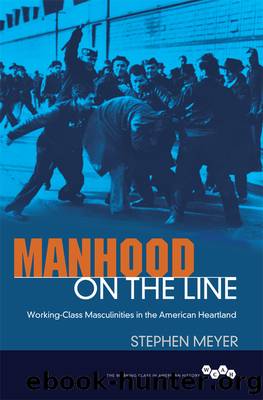Manhood on the Line by Stephen Meyer

Author:Stephen Meyer [Meyer, Stephen]
Language: eng
Format: epub
Tags: Social Science, General, Gender Studies, Political Science, Labor & Industrial Relations, Men's Studies
ISBN: 9780252098253
Google: FgrbCwAAQBAJ
Publisher: University of Illinois Press
Published: 2016-04-15T04:09:03+00:00
6
The Female âInvasionâ
Women and the Male Workplace, 1940â1945
The densely masculine auto manufacturing workplace was essentially the creation of men and mirrored many of the rough elements in male culture. Though native-born and immigrant women worked in the automobile industry almost from its origins, their numbers were never large until World War II, typically from 5 percent to 10 percent of the workforce. Frequently, women were relegated to their separate spaces in the automobile factories, away from men in the cut-and-sew operations and to the light-assembly and machining operations in manufacturing small automobile parts. The outbreak of World War II, with its huge increase in the volume of defense production and with the eventual departure of male workers to European and Asian battlefields, caused severe labor shortages in American plants and factories. As the war progressed, the auto and (later) aircraft industries brought more women into positions formerly reserved for men. These new female workers challenged the privileged position and dominance of men on the shop floor and tested the premises of the densely male shop culture. They rearranged and reconfigured the social contours of the automotive workplace.
Although white American and immigrant women worked limited genderstereotyped positions, black women were notably absent from automotive workplaces, except as janitors for womenâs restrooms. The wartime labor shortages brought large numbers of women into defense plants that produced the autos, trucks, tanks, and aircraft for war. Their presence raised management fears and concerns about the potential for the disruption of smooth workplace and industrial relations. For many managers and male workers, the solidly masculine shop floor was definitely not considered a place for women.
The war years changed all that. Women challenged and threatened the male domination of the workplace.1 The War Manpower Commission labeled the massive influx of women âIndustryâs Petticoat Army.â In the automobile industry, for example, women constituted a small proportion of the total workforce as of April 1941. The 31,600 women employed in automobile plants and factories constituted only 5.4 percent of the total workforce. In contrast, the 199,400 women employed in October 1943 represented more than one-fourth (25.7 percent) of the entire automobile workforce. The aircraft industry also had few women at the outbreak of World War II. âBut,â Gregory W. Chester noted, âby the end of November 1943, a significant change had taken place: the government contracting aircraft engine and propeller plants employed 486,073 women, representing 37 percent of the entire industryâs working force.â By this time, aircraft plants, âwhich had employed either no women or only 1 percent in 1941, were employing from 25 to 52 percent female labor and some plants making small parts employed as much as 60 to 70 percent.â2 In the peak years of war production, women workers became a formidable presence on the auto and aircraft shop floor.
The increased presence of women meant the managers, union leaders, and workers needed to make their social and cultural accommodations with the new workplace conditions. Some managers recognized the fundamentally male character of the many shops and factories of wartime industries.
Download
This site does not store any files on its server. We only index and link to content provided by other sites. Please contact the content providers to delete copyright contents if any and email us, we'll remove relevant links or contents immediately.
The Secret History by Donna Tartt(18764)
The Social Justice Warrior Handbook by Lisa De Pasquale(12087)
Thirteen Reasons Why by Jay Asher(8744)
This Is How You Lose Her by Junot Diaz(6708)
Weapons of Math Destruction by Cathy O'Neil(6090)
Zero to One by Peter Thiel(5643)
Beartown by Fredrik Backman(5554)
The Myth of the Strong Leader by Archie Brown(5380)
The Fire Next Time by James Baldwin(5205)
How Democracies Die by Steven Levitsky & Daniel Ziblatt(5101)
Promise Me, Dad by Joe Biden(5041)
Stone's Rules by Roger Stone(4994)
100 Deadly Skills by Clint Emerson(4803)
A Higher Loyalty: Truth, Lies, and Leadership by James Comey(4803)
Rise and Kill First by Ronen Bergman(4663)
Secrecy World by Jake Bernstein(4599)
The David Icke Guide to the Global Conspiracy (and how to end it) by David Icke(4563)
The Farm by Tom Rob Smith(4409)
The Doomsday Machine by Daniel Ellsberg(4380)
